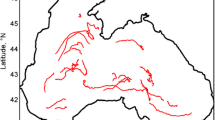Abstract
This paper introduces a modified formula for geostrophic current. The method is based on utilization of the Volterra series expansion in the geostrophic current equation. The purpose of this method is to transform the time series JASON-1 satellite altimeter data into a real ocean surface current. Then, the Volterra kernel inversion used to acquire the sea surface current velocity. In doing so, the finite element model of Lax-Wendorff scheme used to determine the spatial variation of current flow. The results show that the new formula of geostrophic current is able to avoid the impact of Coriolis and geoid parameters. The second-order Volterra kernel illustrates an error standard deviation of 0.03, thus performing a better estimation of flow pattern as compared to first-order Volterra kernel. We conclude that modeling of sea surface current by using JASON-1 satellite altimeter data can be operationalized by using the new formula for geostrophic current.
Access this chapter
Tax calculation will be finalised at checkout
Purchases are for personal use only
Preview
Unable to display preview. Download preview PDF.
Similar content being viewed by others
References
Alejandro, C., Nasir, M.S.: Dynamic behavior of the upper layers of the South China Sea. In: Proceeding of the national conference on climate change, Universiti Pertanian Malaysia, Serdang, Selangor, Malaysia, August 12-13, pp. 135–140 (1996)
AVISO/Altimetry, AVISO user handbook for merged TOPEX/POSEIDON products. AVI-NT-02-101, ed. 3.0. AVISO (1996)
Balaha, J.B.L.: Calibrating altimetry to geopotential anomaly and isotherm depths in the western North Atlantic. Journal geophysical research 97, 7465–7477 (1992)
Gil, M., Malanotte-Rizzoli, P.: Data assimilation in meteorology and oceanography. Advance geophysics 33, 141–266 (1991)
Glenn, S.M., Poorter, D.L., Robinson, A.R.: A synthetic geoid validation of Geosat mesoscale dynamic topography in the Gulf Stream region. Journal geophysical research 96, 7145–7166 (1991)
Ikeda, M.: Mesoscale Variability revealed with sea surface topography measured by altimeters. In: Ikeda, M., Dobson, F.W. (eds.) Oceanographic applications of remote sensing, pp. 15–25. CRC, New York (1991)
Inglada, J., Garello, R. (1999). Depth estimation and 3D topography reconstruction from SAR images showing underwater bottom topography signatures. In: Proceedings of IGARSS 1999 (1999)
Inglada, J., Garello, R.: On Rewriting the Imaging Mechanism of Underwater Bottom Topography by Synthetic Aperture Radar as a Volterra Series Expansion. IEEE Journal of oceanic engineering 27, 665–674 (2002)
Imawaki, S., Unchida, H., Ichikawa, K., Ambe, D.: Estimating the High-Resolution Mean sea-Surface Velocity Field by Combined Use of Altimeter and Drifter Data for Geoid Model Improvement. Space science reviews 108, 195–204 (2003)
Kelly, K., Gille, S.: Gulf Stream surface transport and statistics at 69º W from the Geosat altimeter. Journal geophysical research 59, 3149–3161 (1990)
Hu, J., Kawamura, H., Hong, H., Kobashi, F., Wang, D.: 3-6 Months Variation of Sea surface Height in The South China Sea and Its Adjacent Ocean. Journal oceanography 57, 69–78 (2001)
Hawang, C., Chen, S.A.: Fourier and Wavelet analyses of TOPEX/Poseidon derived Sea Level anomaly over the South China Sea: A contribution to the South China Sea Monsoon Experiment. Journal of geophysical research 105, 28785–28804 (2000)
Liska, L., Wendroff, B.: Composite schemes for conservation laws. SIAM Journal numerical analysis 35(6), 2250–2271 (1998)
Maged, M., Mazlan, H.: Three–Dimensional Reconstruction of bathymetry Using C-Band TOPSAR. Data. Photogrammetri-Fernerkundung Geoinformation, S469–S480 (June 2006)
Maged, M., Mazlan, H., Cracknell, A.: Volterra algorithm for modeling dea surface current circulation from satellite altimetry data. In: Gervasi, O., Murgante, B., Laganà, A., Taniar, D., Mun, Y., Gavrilova, M.L. (eds.) ICCSA 2008, Part II. LNCS, vol. 5073, pp. 119–128. Springer, Heidelberg (2008)
Martins, C.S., Hamann, M., Fiuza, A.F.G.: Surface Circulation in the Eastern North Atlantic from Drifters and Altimetry. Journal of geophysical research 107, 10.1–10.22 (2002)
Mohd, I., Ahemd, S., Wah, F., Chin, K.: Water Circulation Pattern from Sea Surface Current and Chlorophyll-A Derived Using Satellite Data in the South China Sea. Paper Presented at the 2nd International Hydrographic and Oceanographic Conference and exhibition 2005 (IHOCE 2005), Kuala Lumpur, Malaysia, July 5-7 (2005)
Moore, A.M.: Data assimilation in quasigeostrophic open ocean model of the Gulf Stream region using adjoint method. Journal physical oceanography 21, 398–427 (1991)
Morimote, A., Matsuda, T.: The application of Altimetry data to the Asian Marginal Seas. In: Proceedings of IEEE International IGARSS 2005, vol. 8, pp. 5432–5435 (2005)
Robinson, I.S.: Measuring the oceans from Space. In: Principles and Methods of Satellite Oceanography. Springer and Praxis Publishing, Chichester (2004)
Rugh, W.: Nonlinear system theory: The Volterra/Wiener Approach. Johns Hopkins University Press, Baltimore (1981)
White, W., Ttai, C., Holland, W.R.: Continuous assimilation of simulated Geosat altimetry sea level into an eddy-resolving numerical model. I. Sea level differences, Journal geophysical research 95, 3219–3233 (1990)
Wyrtki, K.: Physical Oceanography of the South-East Asian Waters. In: NAGA Report, vol. 2, Univ. Calif. Scripps Inst. Ocean, La Jolla (1962)
Author information
Authors and Affiliations
Editor information
Editors and Affiliations
Rights and permissions
Copyright information
© 2009 Springer-Verlag Berlin Heidelberg
About this chapter
Cite this chapter
Marghany, M. (2009). Volterra – Lax-Wendroff Algorithm for Modelling Sea Surface Flow Pattern from Jason-1 Satellite Altimeter Data. In: Gavrilova, M.L., Tan, C.J.K. (eds) Transactions on Computational Science VI. Lecture Notes in Computer Science, vol 5730. Springer, Berlin, Heidelberg. https://doi.org/10.1007/978-3-642-10649-1_1
Download citation
DOI: https://doi.org/10.1007/978-3-642-10649-1_1
Publisher Name: Springer, Berlin, Heidelberg
Print ISBN: 978-3-642-10648-4
Online ISBN: 978-3-642-10649-1
eBook Packages: Computer ScienceComputer Science (R0)




